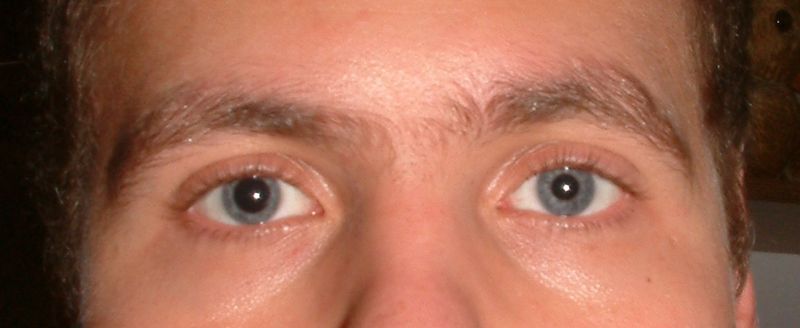Anisocoria
| Anisocoria | |
 | |
|---|---|
| Anisocoria | |
| ICD-10 | H57.0 |
| ICD-9 | 379.41 |
| OMIM | 106240 |
| DiseasesDB | 724 |
| eMedicine | emerg/29 neuro/479 oph/160 |
| MeSH | D015875 |
Template:Search infobox Editor-In-Chief: C. Michael Gibson, M.S., M.D. [1]
Anisocoria is a condition characterized by an unequal size of the pupils.
Causes
To a certain extent, this is normal. Anisocoria to a mild degree (generally 0.3 to 0.5 mm) can be found in about 20% of people. This form is termed "simple anisocoria." When pathological, it may be seen in a variety of nervous system pathologies such as Wernicke-Korsakoff syndrome.
In the absence of any deformities of the iris or eyeball proper, anisocoria is usually the result of a defect in efferent nervous pathways controlling the pupil traveling in the oculomotor nerve (parasympathetic fibers) or the sympathetic pathways. Physical lesions and drugs causing anisocoria will do so via disruption of these pathways.
Some examples of drugs which may affect the pupils include pilocarpine, cocaine, tropicamide and scopolamine.
Additionally, dilation of the pupil is termed mydriasis and constriction of the pupil is termed miosis.
Complete Differential Diagnosis of Anisocoria
- Adie's Syndrome
- Alcohol intoxication
- Aniridia
- Argyll-Robertson Pupil
- Arsenic poisoning
- Botulism
- Brain tumor
- Cavernous sinus thrombosis
- Cerebral aneurysm
- Congenital
- Degenerative neurologic disorders
- Diabetes Mellitus
- Diphtheria
- Drugs
- Encephalitis
- Herpes Zoster
- Horner's Syndrome
- Injury to the iris
- Internal carotid artery aneurysm
- Intracranial hemorrhage
- Iridocyclitis
- Ischemia
- Keratitis
- Lead poisoning
- Meningitis
- Multiple Sclerosis
- Narrow Angle Glaucoma
- Neoplastic
- Neurofibromatosis
- Ocular prosthesis
- Retinal disease
- Syphilis
- Syringomyelia
- Tabes Dorsalis
- Trauma
- Tuberculosis
Interpretation
Clinically, it is important to establish which of the two pupils is behaving abnormally.
- If the smaller of the two pupils is the abnormal one, dimming the ambient light will not cause it to dilate, in which case a defect in sympathetic fibers is suspected, as seen in Horner's syndrome.
- Alternatively, if the abnormal pupil is the larger one, it will fail to contract in response to light, raising suspicion for a parasympathetic nerve defect, possibly an oculomotor nerve palsy.
A relative afferent pupillary defect or RAPD also known as a Marcus Gunn pupil does not cause anisocoria.
When anisocoria occurs and the examiner is unsure whether the abnormal pupil is the constricted or dilated one, if a one-sided ptosis is present then the abnormally sized pupil can be presumed to be the one on the side of the ptosis.
See also
References
Additional Resources
- "Anisocoria." Stedman's Medical Dictionary, 27th ed. (2000). ISBN 0-683-40007-X
- Victor, Maurice and Allan H. Ropper. Adams and Victor's Principles of Neurology, 7th ed. (2001). ISBN 0-07-067497-3